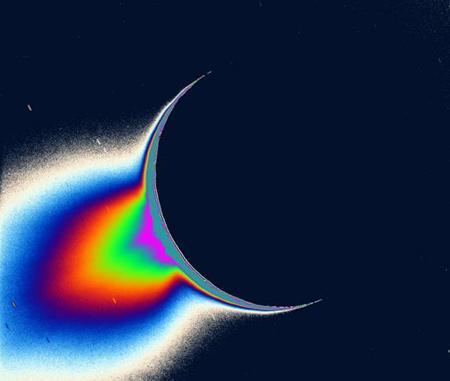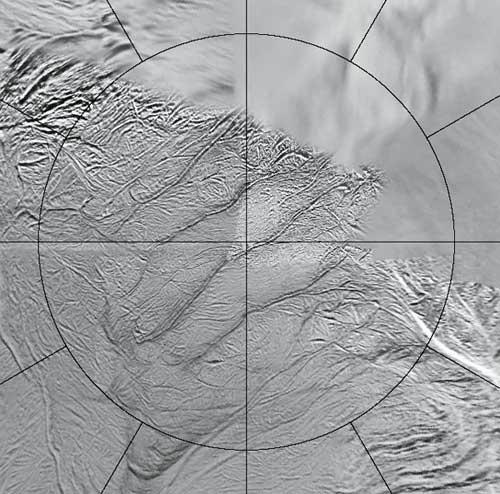Researchers propose to analyze the relationship between methane and other organic compounds as measured by the Cassini spacecraft pass through the plume of dust and ice ejected from Enceladus in August of this year

After the Cassini spacecraft transmitted the most detailed images of Saturn's moon Enceladus, which is 500 kilometers in diameter, it's no wonder scientists are excited about the little moon. However, a new study recently published seeks to analyze the composition of the ice-yorki geysers at the south pole of Enceladus.
In some computer models, this plume is attributed to a subsurface ocean. This possibility has led scientists to speculate that such an ocean might be an ideal environment in which basic life forms could survive. The problem - the Cassini spacecraft is not equipped with systems that would allow to discover life directly, it may be possible to use it to locate the signature of life.
The new study, published inThe Astrobiological Journal, led by Christopher McKay of NASA's Ames Research Center in Moft Field, California, who speculates that Cassini has already collected enough data to be analyzed in the search for extraterrestrial life. By filtering the particles collected by the spacecraft after it passed through the plume consisting of gas and ice particles emitted from the South Pole, and to see if it contains organic substances such as methane. It seems that Enceladus has the mixture of the components important for life, and it distributes them into space. "If you think about what is required for existence of life, it seems that it is water, energy, organic materials and nitrogen, and all these things are in the plume" said McKay. "We have a small world that seems to have everything.

What life can be found there? A good chance of finding a micro-organism of the type that McCay calls methanogens (as the name suggests, they produce methane as a by-product of their biological cycle). This could be a possible explanation but there must also be a correct ratio of organic compounds (mainly methane) present in the plume.
According to McKay's team, if the organic compounds discovered in the plume are of biological origin, there must be a higher concentration of methane than of heavier organic components (for example, non-methane hydrocarbons). The article suggests examining whether the ratio between the methane and the other organic substances should be less than 0.0001, then a sign that the source is biological.
This method has recently been used in hot water springs on the bottom of the Atlantic Ocean where a higher ratio was measured, indicating that the gas emitted from the spring is not of biological origin. The researchers propose to use the ion detector mass spectrometer (INMS) in a way similar to the one used on Earth, to detect organic substances in the plumes of Enceladus, and to determine whether they are the product of biological processes. However, previous passes of the spacecraft near the Andalusian plume revealed that its composition is similar to that of a comet and therefore it is an ancient source of the organic components and therefore it is necessary to collect additional data and improve the model.
This study increases the encouragement for further studies of the moons of the gas giants, and it is hoped that more sensitive equipment placed in orbit around Saturn will be able to refine Cassini's initial findings. In any case, to know whether the origin of the erogenic compounds in Enceladus is from a biological process, we will still have to wait.
For the news in Universe Today
More of the topic in Hayadan:

11 תגובות
9 You are absolutely right, there are a lot of aliens on Earth too, some of them also infiltrated NASA
And some even send talkbacks here
What stupidity and stupidity. NASA is the largest organization in the world that was founded to hide the fact that there is still life from the public. They change and edit the pictures from Mars regularly so we don't know what's going on there. There are testimonies of most of the astronauts who saw UFOs in most of the manned missions and continue to lie as if nothing ever happened.
Are the angels aliens??? Belial Samal Azazel and all the guys came from outer space? It's a theory I've never heard before! And what about Lilit? And Ashmadai, the king of demons, do you believe in that too?
Society:
I do not understand why you are trying to develop the topic anew.
A lot of work has already been done on this matter, but at this stage they do not want to change any of the stars in order to be able to correctly find out if life was created there independently.
They even take great care to disinfect everything that is sent there so as not to accidentally plant life that originates from the earth there.
The idea of "sowing life instead of looking for life" is somewhat similar to the idea of "infecting a disease instead of checking for a disease".
In relation to creating conditions suitable for life on Mars, you should read here:
http://en.wikipedia.org/wiki/Terraforming_of_Mars
Only a limited number of germs can really adapt to the environment there
So they need to be limited to a very small number of bacteria and germs
that give a positive output like the cyanobacteria that know how to produce atmospheric oxygen sounds excellent
And no germs that will poison the environment and the air
It requires planning
On the order of a planet this can get out of control very quickly
And it will be difficult to impossible to correct the mistakes
When time is the important thing.
Sorry, error correction: Should a complex environment or one bacterium (or a very limited number of bacteria) be taken for seeding?
age,
Nice idea
What bacteria would you suggest seeding on Mars?
For example, cyanobacteria that can produce atmospheric oxygen like higher plants and that do not require an aerobic environment? Maybe sulfur recycling bacteria? What about algae? Do you think that a complex environment of life should be seeded (ie more than one kind of bacteria) or maybe complex bacterial samples should be taken - such as sea water, sewage water or soil samples from Earth and simply seeded on Mars? Necrosis.
: )
Best regards,
Ami Bachar
Instead of spending money to look for a life
You can sow life
Let's take Mars for example
It can be bombarded with resistant germs that will start the establishment process
and changing the atmosphere
Within a period of time the atmosphere could allow water on the surface of Mars
Then it can be sown with suitable plants.
A process that took millions of years on Earth
can be carried out on the surface of Mars in only decades.
It is not written in any scripture that there is no life in other places, on the contrary, the religion talks about many types of life. For example, living in higher worlds (angels, etc.).
Find a life already! And shut up to all the religious people and their "creation stories"!